Nanoindentation Reveals Crosslinking Behavior of Solar Encapsulants—The Methodological Advantages over Bulk Methods
Abstract
:1. Introduction
- Small sample size and reduced scale tests.
- Possibility to investigate multilayered material combinations (reduced sample preparation compared to DMA).
- Accurate and advanced tests for time-dependent materials like viscoelastic polymers.
- Spatial resolution allows to study the homogeneity of mechanical parameters along surfaces [22].
- Automated and Instrumented technique with good reproducibility.
2. Background
2.1. Creep Measurements: Ramp and Hold Indentation
2.2. Dynamic Frequency Sweep: Sinus Indentation
3. Materials and Methods
3.1. Lamination and Sample Preparation
3.2. Differential Scanning Calorimetry (DSC)
3.3. Nanoindentation
- The Ultra-Nanoindentation Testing (UNHT³) (Figure 2) with sphero-conical indenter tip geometry.
- The Nanoindentation Testing (NHT²) with flat punch-end conical indenter tip geometry.
3.4. Dynamic Mechanical Analysis (DMA)
- Shear mode (Figure 9): 3 samples (backsheet-EVA laminate) were prepared as described in Section 3.1.
- Tensile mode (Figure 9): 3 samples (EVA) were prepared as described in Section 3.1.
4. Results and Discussion
4.1. Crosslinking Determination by DSC
4.2. Creep Measurement Data to DoC Correlation
4.3. Correlation of Dynamic Nanoindentation Data to DoC
4.4. Correlation of Tensile DMA Measurement Data to DoC
4.5. Nanoindentation vs. DMA-Test-Retest Reliability
5. Conclusions and Outlook
Author Contributions
Funding
Institutional Review Board Statement
Informed Consent Statement
Data Availability Statement
Acknowledgments
Conflicts of Interest
References
- Mesquita, L.V.; Mansour, D.E.; Gebhardt, P.; Pitta Bauermann, L. Scanning acoustic microscopy analysis of the mechanical properties of polymeric components in photovoltaic modules. Eng. Rep. 2020, 2, e12222. [Google Scholar] [CrossRef]
- Mühleisen, W.; Biebl-Rydlo, M.; Spielberger, M. Determining the Degree of EVA Cross-Linking in Assembled PV Modules Acoustically and In-situ. In Proceedings of the 26th European Photovoltaic Solar Energy Conference, Hamburg, Germany, 5–9 September 2011. [Google Scholar] [CrossRef]
- Li, H.Y.; Perret-Aebi, L.E.; Théron, R.; Ballif, C.; Luo, Y.; Lange, R.F. Optical transmission as a fast and non-destructive tool for determination of ethylene-co-vinyl acetate curing state in photovoltaic modules. Prog. Photovoltaics Res. Appl. 2013, 21, 187–194. [Google Scholar] [CrossRef]
- Malguth, E.; Buhl, B.; Schenk, T. Fast and Non-Destructive Determination of the EVA Cross-Linking Degree for In-Line and Off-Line Application. In Proceedings of the 28th European Photovoltaic Solar Energy Conference and Exhibition, Paris, France, 30 September–4 October 2013; pp. 472–475. [Google Scholar] [CrossRef]
- Lux, C.; Blieske, U.; Malguth, E.; Bogdanski, N. Variations in Cross-Link Properties of EVA of Un-Aged and Aged PV-Modules. In Proceedings of the 29th European Photovoltaic Solar Energy Conference and Exhibition, Amsterdam, The Netherlands, 23–25 September 2014; pp. 2462–2466. [Google Scholar] [CrossRef]
- Kunath, S.; Vogel, M.; Mette, M.; Malguth, E. Evaluation of Gel Content-Measurement-Method for Mass Production of Glass-Foil Based Crystalline Silicon PV Modules. In Proceedings of the 31st European Photovoltaic Solar Energy Conference, Hamburg, Germany, 14–18 September 2015. [Google Scholar] [CrossRef]
- Lloyd, J.; Christian, T.; Doble, D.; Mickiewicz, R.A. Non-destructive measurement of the degree of cross-linking of EVA solar module encapsulation. In Proceedings of the 37th IEEE Photovoltaic Specialists Conference, Seattle, WA, USA, 19–24 June 2011; pp. 2273–2278. [Google Scholar] [CrossRef]
- Hirschl, C.; Biebl–Rydlo, M.; DeBiasio, M.; Mühleisen, W.; Neumaier, L.; Scherf, W.; Oreski, G.; Eder, G.; Chernev, B.; Schwab, W.; et al. Determining the degree of crosslinking of ethylene vinyl acetate photovltaic module encapsulants—A comparative study. Sol. Energy Mater. Sol. Cells 2013, 116, 203–218. [Google Scholar] [CrossRef] [Green Version]
- Miller, D.C.; Owen-Bellini, M.; Hacke, P.L. Use of indentation to study the degradation of photovoltaic backsheets. Sol. Energy Mater. Sol. Cells 2019, 201, 110082. [Google Scholar] [CrossRef]
- Schenk, P.; Pander, M.; Zeller, U.; Jäckel, B.; Ebert, M. Correlation of Peel Forces to EVA Degree of Cross Linking and Accelerated Weathering. In Proceedings of the 37th European Photovoltaic Solar Energy Conference and Exhibition, Freiburg, Germany, 7–11 September 2020. [Google Scholar] [CrossRef]
- Oreski, G.; Rauschenbach, A.; Hirschl, C.; Kraft, M.; Eder, G.C.; Pinter, G. Crosslinking and post-crosslinking of ethylene vinyl acetate in photovoltaic modules. J. Appl. Polym. Sci. 2017, 134, 101. [Google Scholar] [CrossRef]
- Morlier, A.; Klotz, S.; Sczuka, S.; Kunze, I.; Schaumann, I.; Blankemeyer, S.; Siegert, M.; Döring, T.; Alshuth, T.; Giese, U.; et al. Influence of the Curing State of Ethylene-Vinyl Acetate on Photovoltaic Modules Aging. In Proceedings of the 28th European Photovoltaic Solar Energy Conference and Exhibition, Paris, France, 30 September–4 October 2013; pp. 2832–2837. [Google Scholar] [CrossRef]
- Jonai, S.; Hara, K.; Tsutsui, Y.; Nakahama, H.; Masuda, A. Relationship between cross-linking conditions of ethylene vinyl acetate and potential induced degradation for crystalline silicon photovoltaic modules. Jpn. J. Appl. Phys. 2015, 54, 08KG01. [Google Scholar] [CrossRef]
- Zhu, J.; Montiel-Chicharro, D.; Owen-Bellini, M.; Betts, T.; Gottschalg, R. The role of EVA encapsulation in the degradation of wafer based PV modules. In Proceedings of the 12th Photovoltaic Science, Application and Technology Conference C98 (PVSAT-12), Liverpool, UK, 6–8 April 2016; Available online: https://creativecommons.org/licenses/by-nc-nd/4.0/ (accessed on 20 June 2021).
- Zhu, J.; Owen-Bellini, M.; Montiel-Chicharro, D.; Betts, T.R.; Gottschalg, R. Effect of viscoelasticity of ethylene vinyl acetate encapsulants onphotovoltaic module solder joint degradation due to thermomechanical fatigue. Jpn. J. Appl. Phys. 2018, 57, 08RG03. [Google Scholar] [CrossRef] [Green Version]
- Herzog, C.; Mueller, T.; Heinrich, M.; Neuhaus, D.-H. Differential scanning calorimetry for simulation and optimization of PV module lamination. In Proceedings of the 36th European Photovoltaic Solar Energy Conference and Exhibition, Marseille, France, 9–13 September 2019. [Google Scholar] [CrossRef]
- Czanderna, A.W.; Pern, F.J. Encapsulation of PV modules using ethylene vinyl acetate copolymer as a pottant: A critical review. Sol. Energy Mater. Sol. Cells 1996, 43, 101–181. [Google Scholar] [CrossRef]
- Klemchuk, P.; Ezrin, M.; Lavigne, G.; Holley, W.; Galica, J.; Agro, S. Investigation of the degradation and stabilization of EVA-based encapsulant in field-aged solar energy modules. Polym. Degrad. Stab. 1997, 55, 347–365. [Google Scholar] [CrossRef]
- Peike, C.; Kaltenbach, T.; Weiß, K.A.; Koehl, M. Non-destructive degradation analysis of encapsulants in PV modules by Raman Spectroscopy. Sol. Energy Mater. Sol. Cells 2011, 95, 1686–1693. [Google Scholar] [CrossRef]
- Stark, W.; Jaunich, M. Investigation of Ethylene/Vinyl Acetate Copolymer (EVA) by thermal analysis DSC and DMA. Polym. Test. 2011, 30, 236–242. [Google Scholar] [CrossRef]
- Agroui, K.; Collins, G.; Oreski, G.; Boehning, M.; Hadj Arab, A.; Ouadjaout, D. Effect of crosslinking on EVA-based encapsulant properties during photovoltaic module fabrication process. Rev. Energies Renouvelables 2015, 18, 303–314. [Google Scholar]
- Randall, N.X.; Vandamme, M.; Ulm, F.-J. Nanoindentation analysis as a two-dimensional tool for mapping the mechanical properties of complex surfaces. J. Mater. Res. 2009, 24, 679–690. [Google Scholar] [CrossRef]
- Oliver, W.C.; Pharr, G.M. An improved technique for determining hardness and elastic modulus using load and displacement sensing indentation experiments. J. Mater. Res. 1992, 7, 1564–1583. [Google Scholar] [CrossRef]
- Oliver, W.C.; Pharr, G.M. Measurement of hardness and elastic modulus by instrumented indentation: Advances in understanding and refinements to methodology. J. Mater. Res. 2004, 19, 3–20. [Google Scholar] [CrossRef]
- Herbert, E.G.; Oliver, W.C.; Pharr, G.M. Nanoindentation and the dynamic characterization of viscoelastic solids. J. Phys. Appl. Phys. 2008, 41, 74021. [Google Scholar] [CrossRef]
- Christöfl, P.; Czibula, C.; Berer, M.; Oreski, G.; Teichert, C.; Pinter, G. Comprehensive investigation of the viscoelastic properties of PMMA by nanoindentation. Polym. Test. 2020, 93, 106978. [Google Scholar] [CrossRef]
- CSM-Instruments for Advanced Mechanical Surface Testing, Handbook on Instrumented Indentation. Available online: www.csm-instruments.com (accessed on 15 June 2021).
- Feng, G.; Ngan, A.H.W. Effects of Creep and Thermal Drift on Modulus Measurement Using Depth-sensing Indentation. J. Mater. Res. 2002, 17, 660–668. [Google Scholar] [CrossRef] [Green Version]
- Nohava, J.; Menčík, J. A contribution to understanding of low-load spherical indentation—Comparison of tests on polymers and fused silica. J. Mater. Res. 2012, 27, 239–244. [Google Scholar] [CrossRef]
- Nohava, J.; Randall, N.X.; Conté, N. Novel ultra nanoindentation method with extremely low thermal drift: Principle and experimental results. J. Mater. Res. 2009, 24, 873–882. [Google Scholar] [CrossRef] [Green Version]
- Oyen, M.L. Sensitivity of polymer nanoindentation creep measurements to experimental variables. Acta Mater. 2007, 55, 3633–3639. [Google Scholar] [CrossRef]
- Oyen, M.L.; Cook, R.F. A practical guide for analysis of nanoindentation data. J. Mech. Behav. Biomed. Mater. 2009, 2, 396–407. [Google Scholar] [CrossRef]
- Menčík, J.; He, L.H.; Němeček, J. Characterization of viscoelastic-plastic properties of solid polymers by instrumented indentation. Polym. Test. 2011, 30, 101–109. [Google Scholar] [CrossRef]
- Cook, R.F.; Oyen, M.L. Nanoindentation behavior and mechanical properties measurement of polymeric materials. Int. J. Mater. Res. 2007, 98, 370–378. [Google Scholar] [CrossRef]
- Wang, Y.; Shang, L.; Zhang, P.; Yan, X.; Zhang, K.; Dou, S.; Zhao, J.; Li, Y. Measurement of viscoelastic properties for polymers by nanoindentation. Polym. Test. 2020, 83, 106353. [Google Scholar] [CrossRef]
- Oyen, M.L. Spherical Indentation Creep Following Ramp Loading. J. Mater. Res. 2005, 20, 2094–2100. [Google Scholar] [CrossRef]
- Oyen, M.L. Analytical techniques for indentation of viscoelastic materials. Philos. Mag. 2006, 86, 5625–5641. [Google Scholar] [CrossRef]
- Hou, X.D.; Jennett, N.M. Defining the limits to long-term nano-indentation creep measurement of viscoelastic materials. Polym. Test. 2018, 70, 297–309. [Google Scholar] [CrossRef]
- Sepe, M.P. Dynamic Mechanical Analysis for Plastics Engineering; PDL HandbookSeries; Plastics Design Library: Norwich, NY, USA, 1998; ISBN 1884207642. [Google Scholar]
- Cheng, Y.T.; Ni, W.; Cheng, C.M. Nonlinear analysis of oscillatoryindentation in elastic and viscoelastic solids. Phys. Rev. Lett. 2006, 97, 075506. [Google Scholar] [CrossRef] [PubMed] [Green Version]
- Hay, J.; Crawford, B. Measuring substrate-independent modulus of thinfilms. J. Mater. Res. 2011, 26, 727–738. [Google Scholar] [CrossRef]
- Dynamic Mechanical Analysis by Nanoindentation. Available online: www.anton-paar.com (accessed on 14 June 2021).
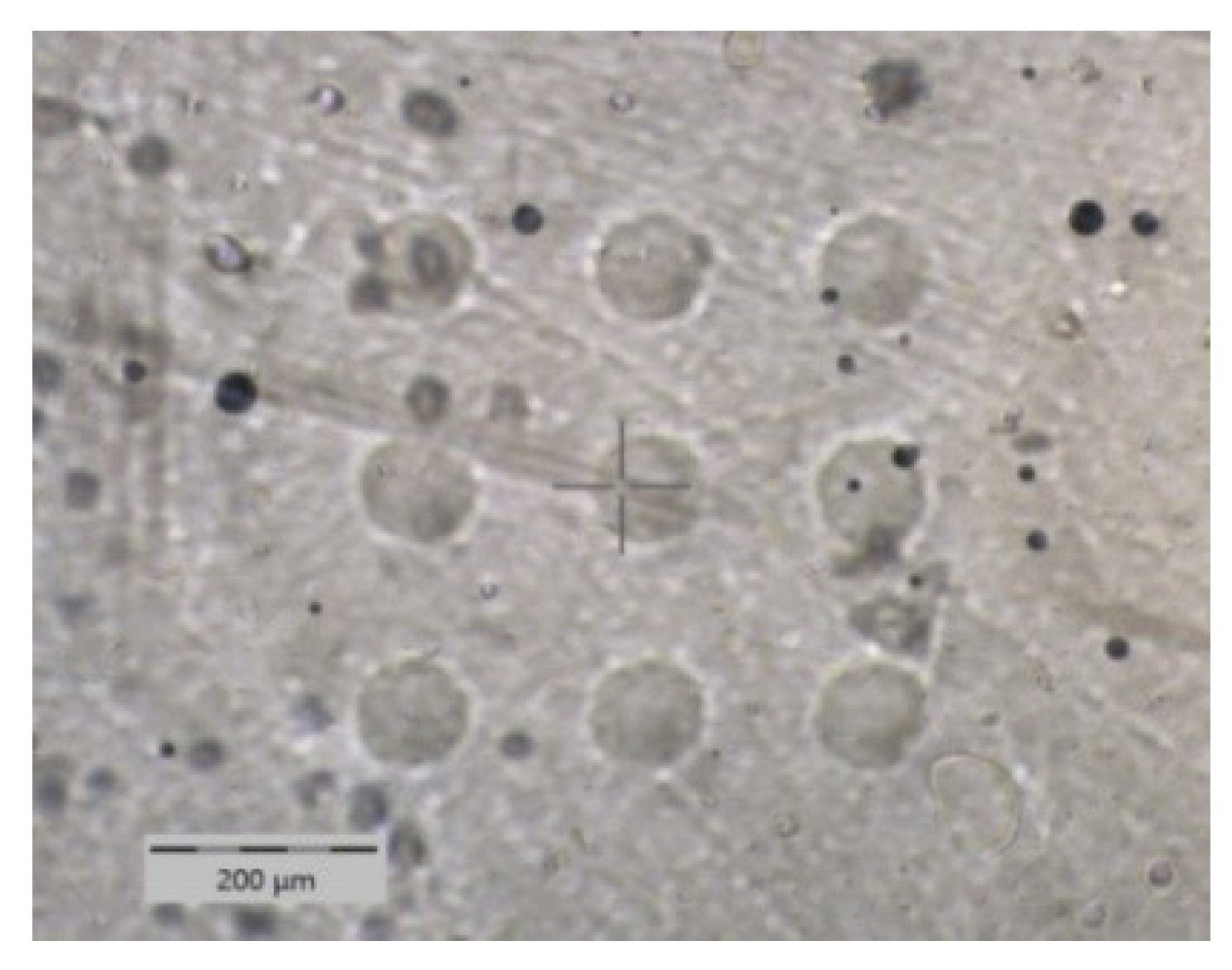
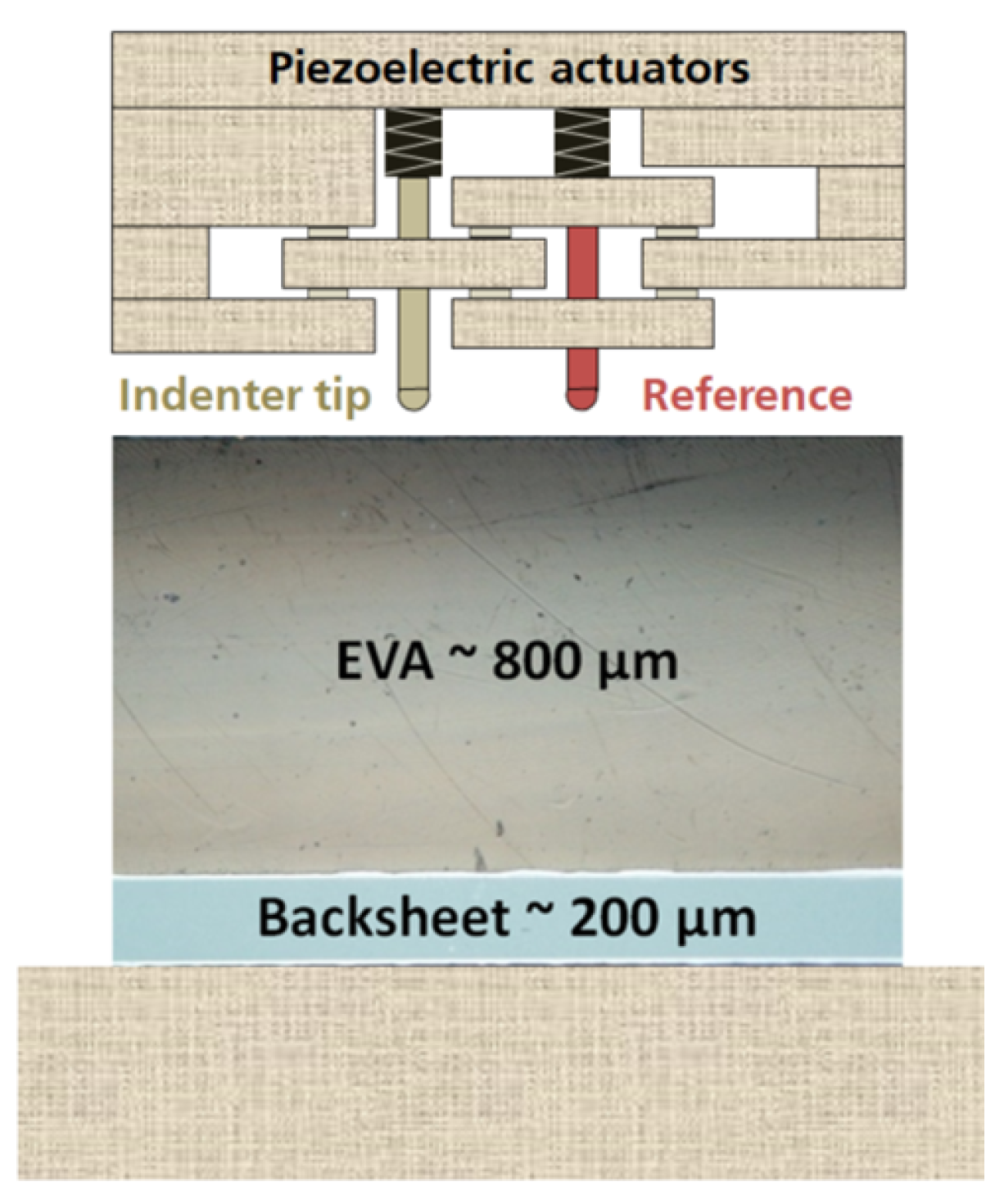
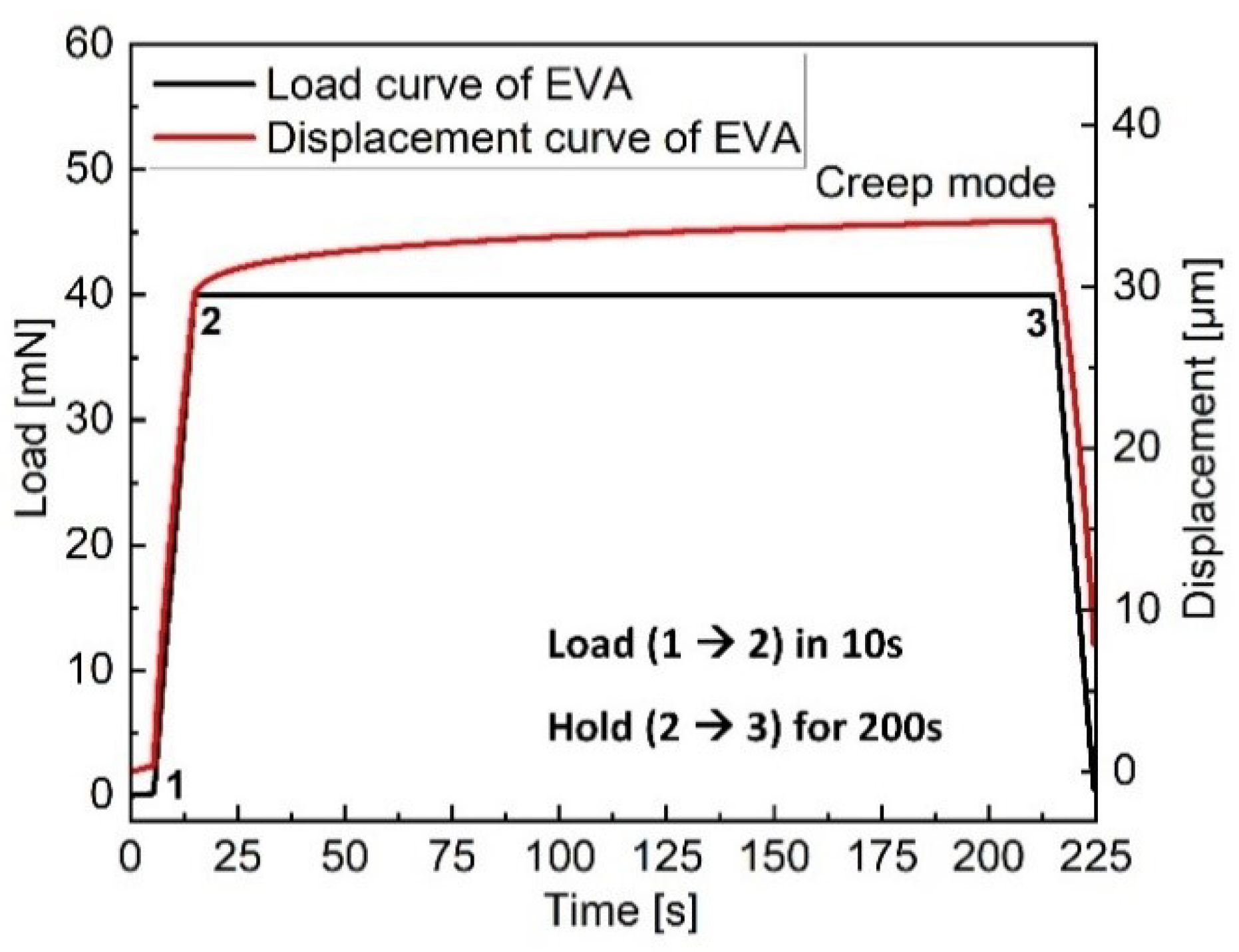


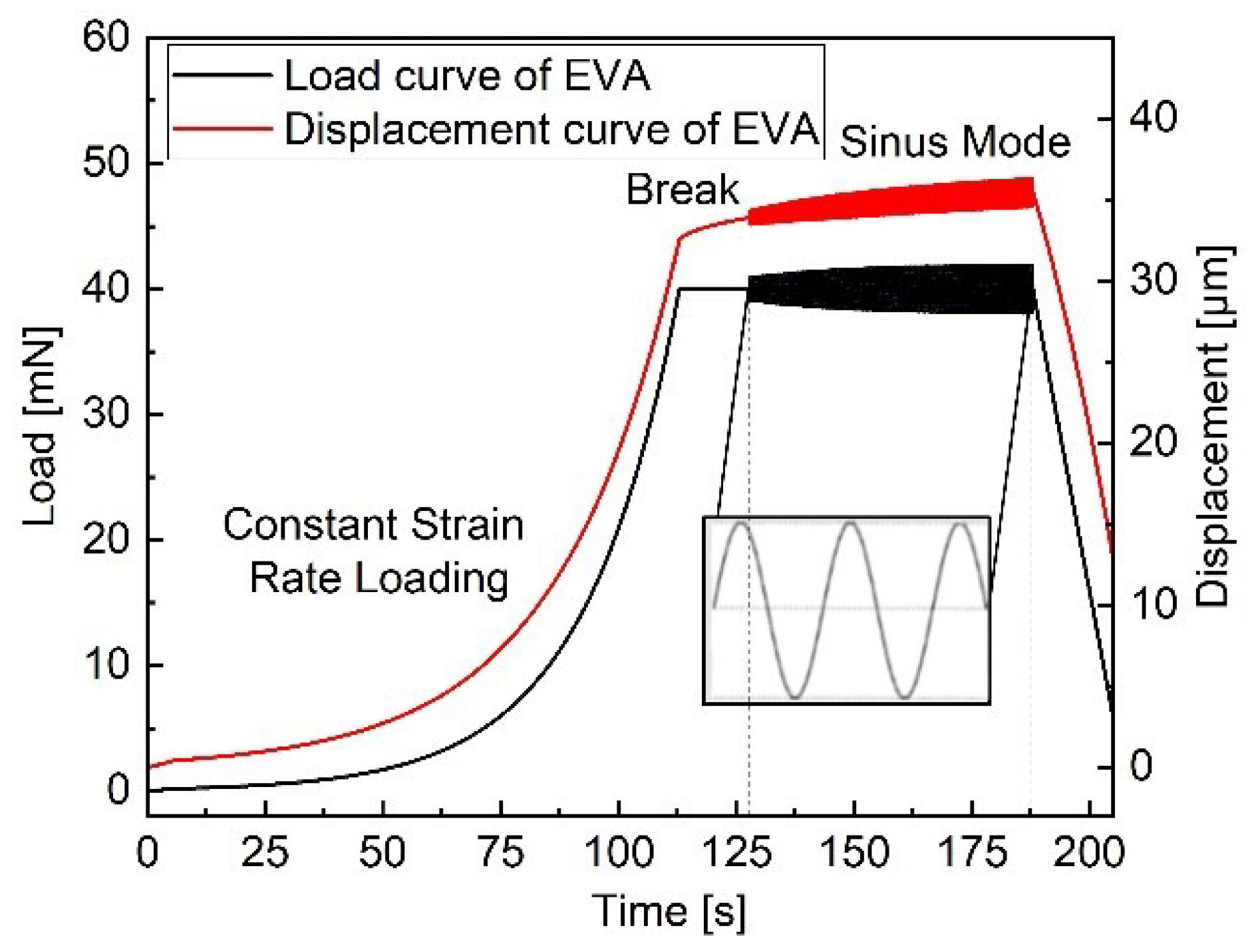

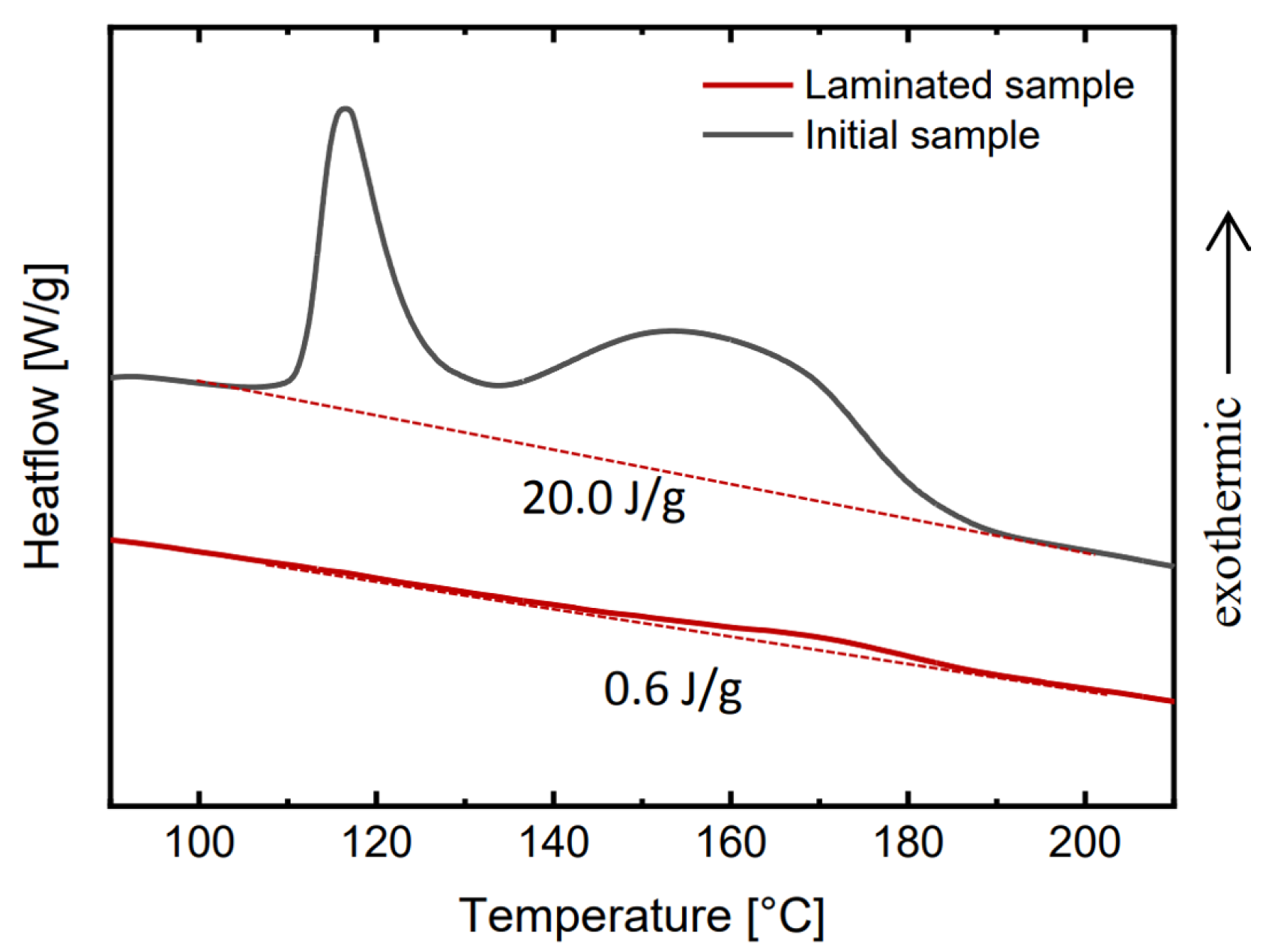

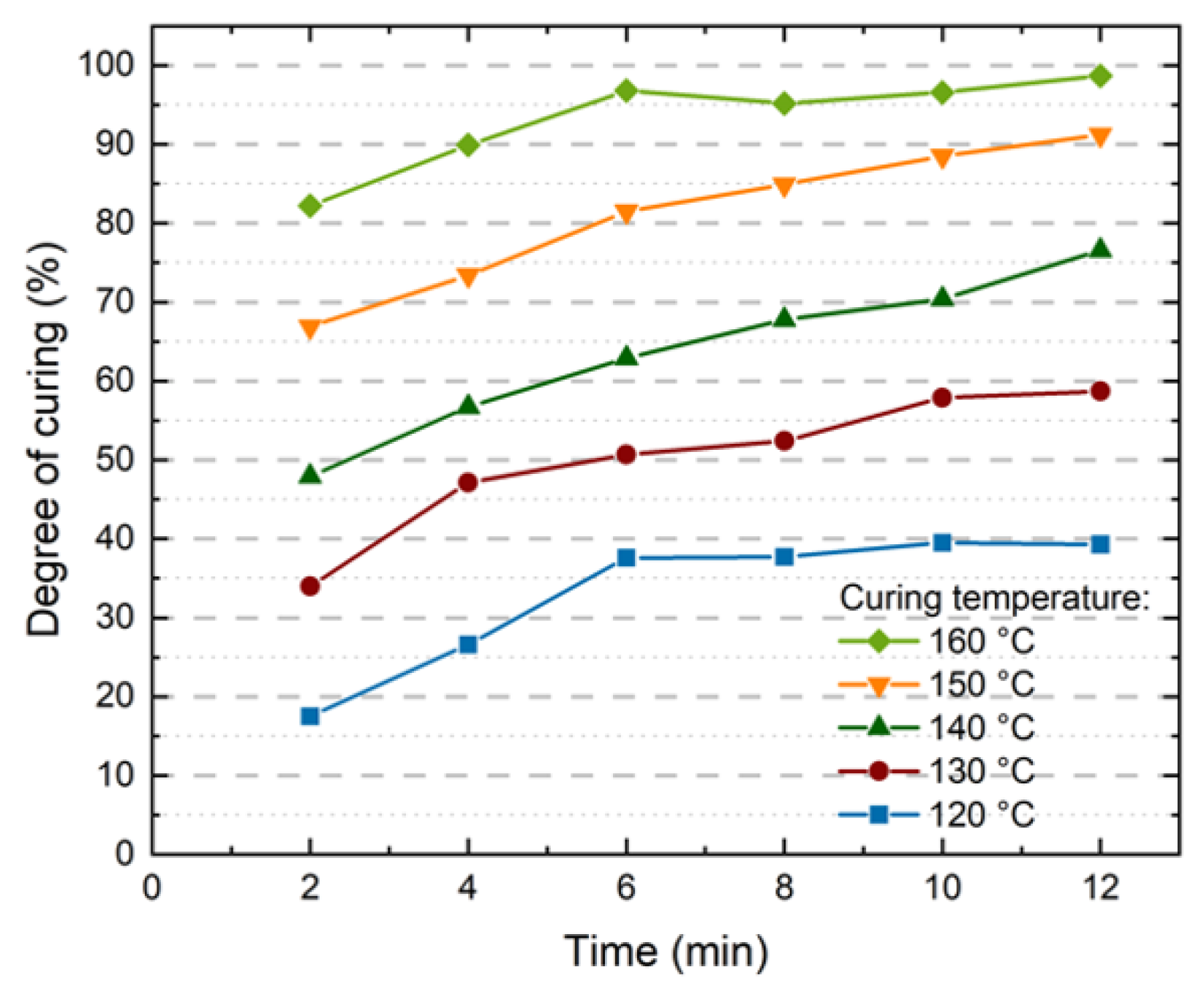
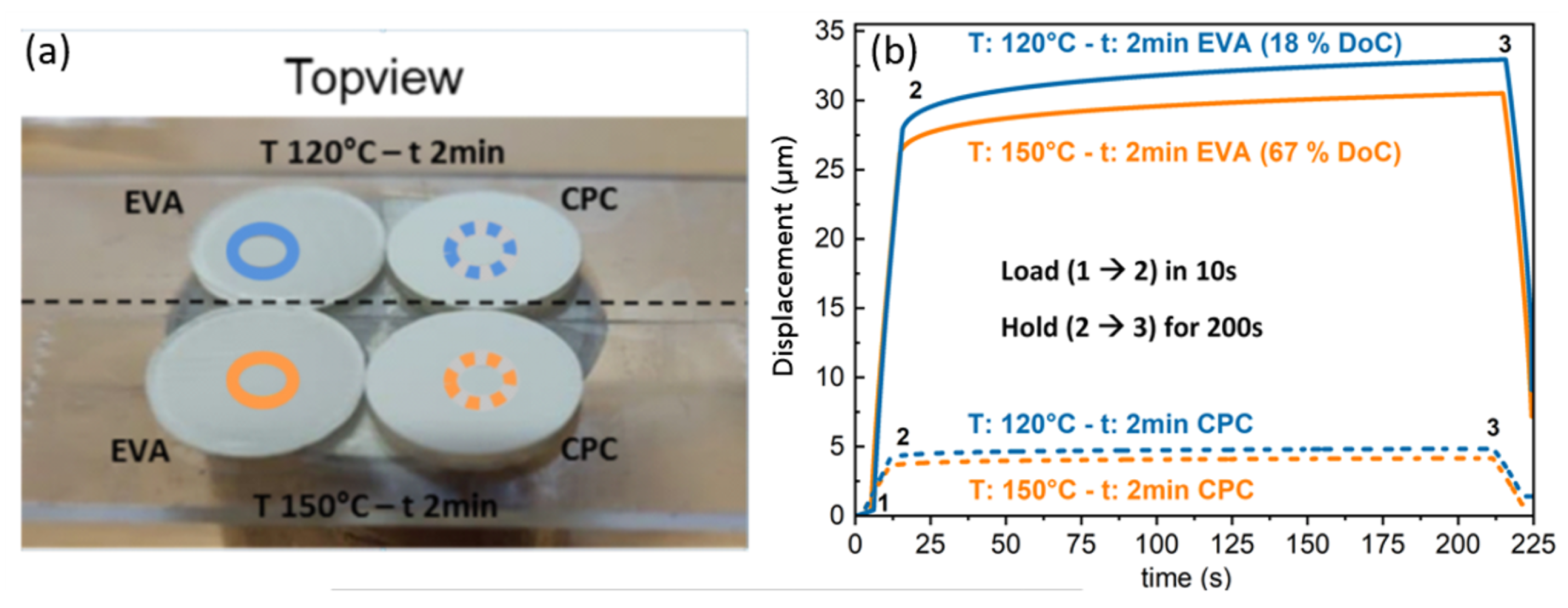
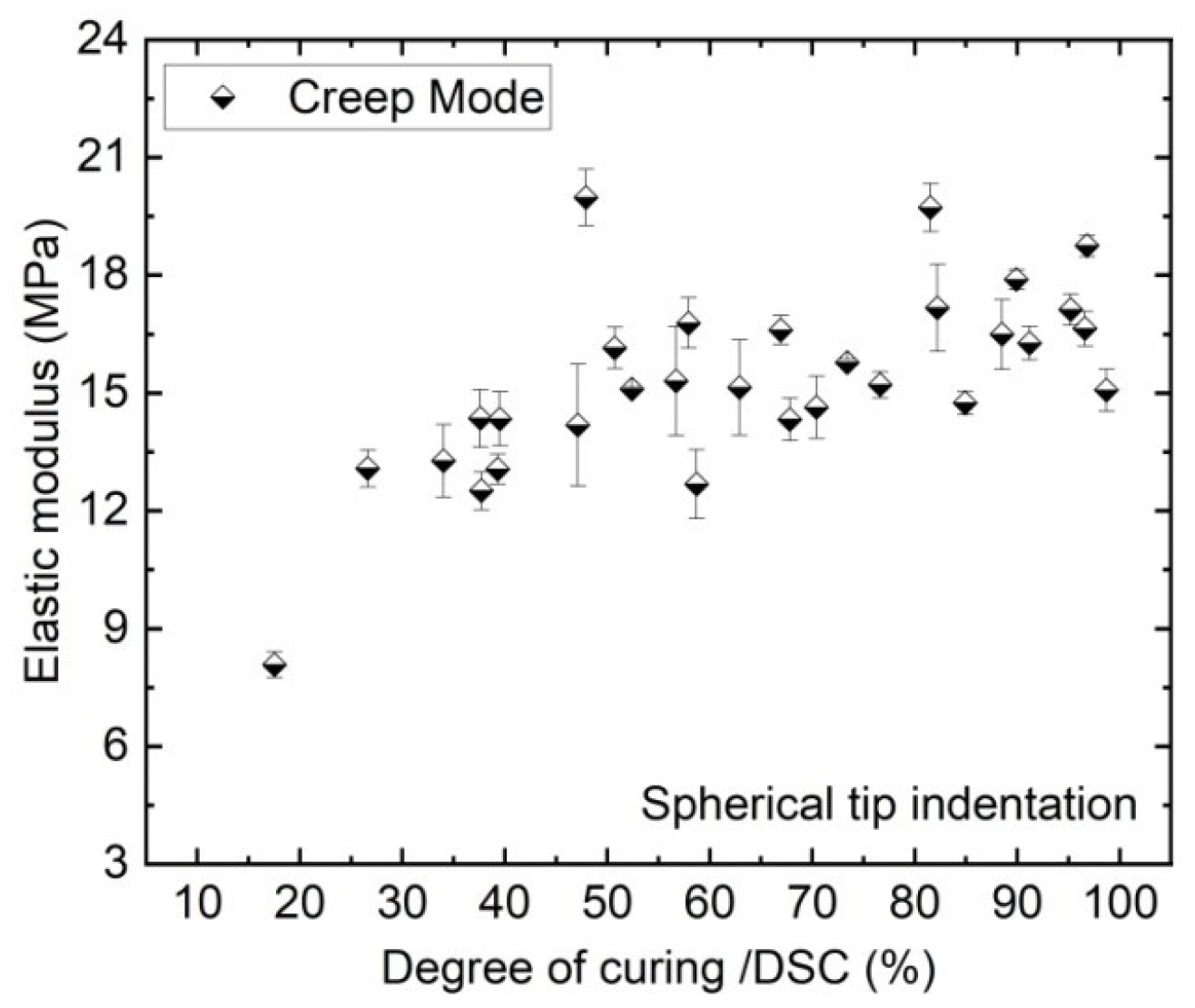

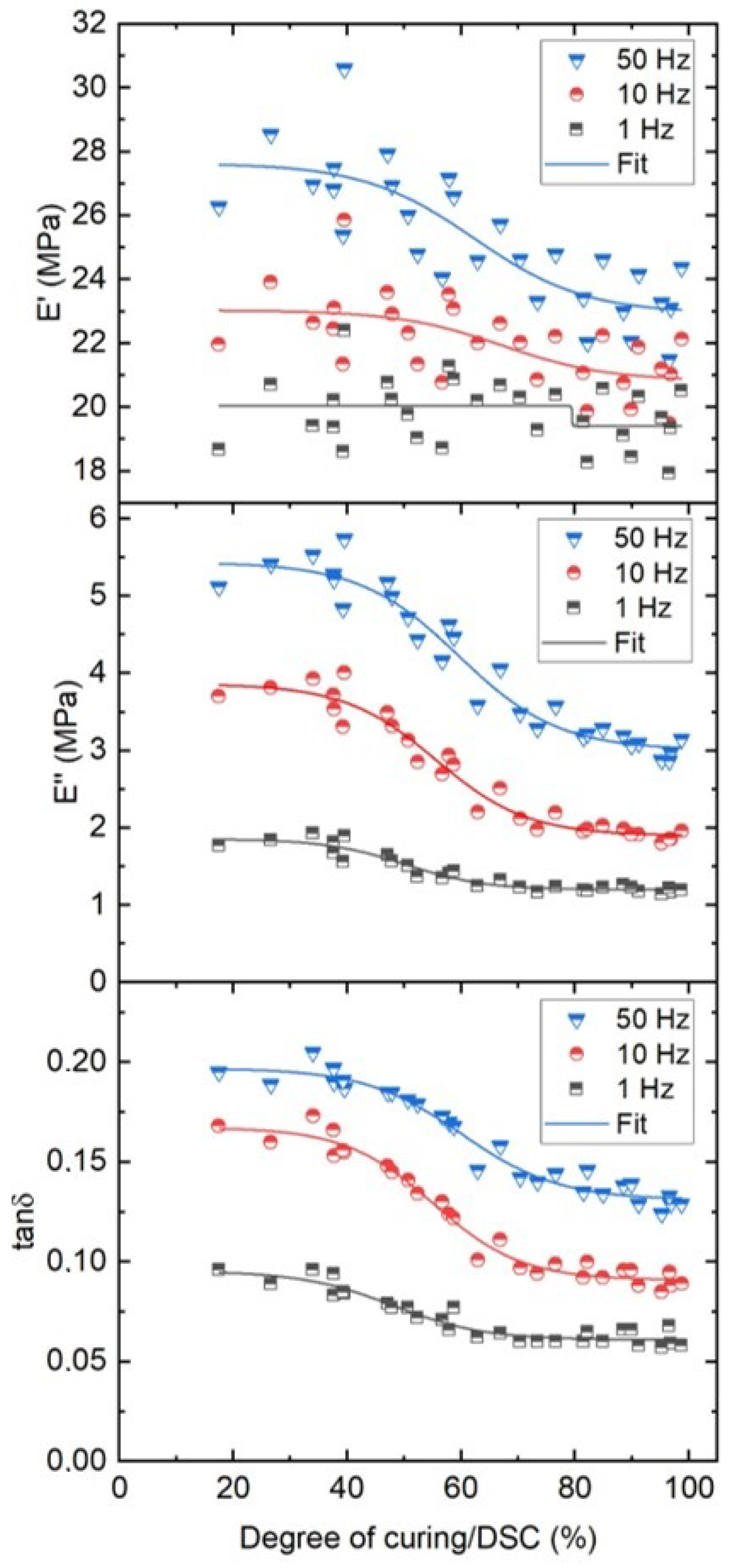
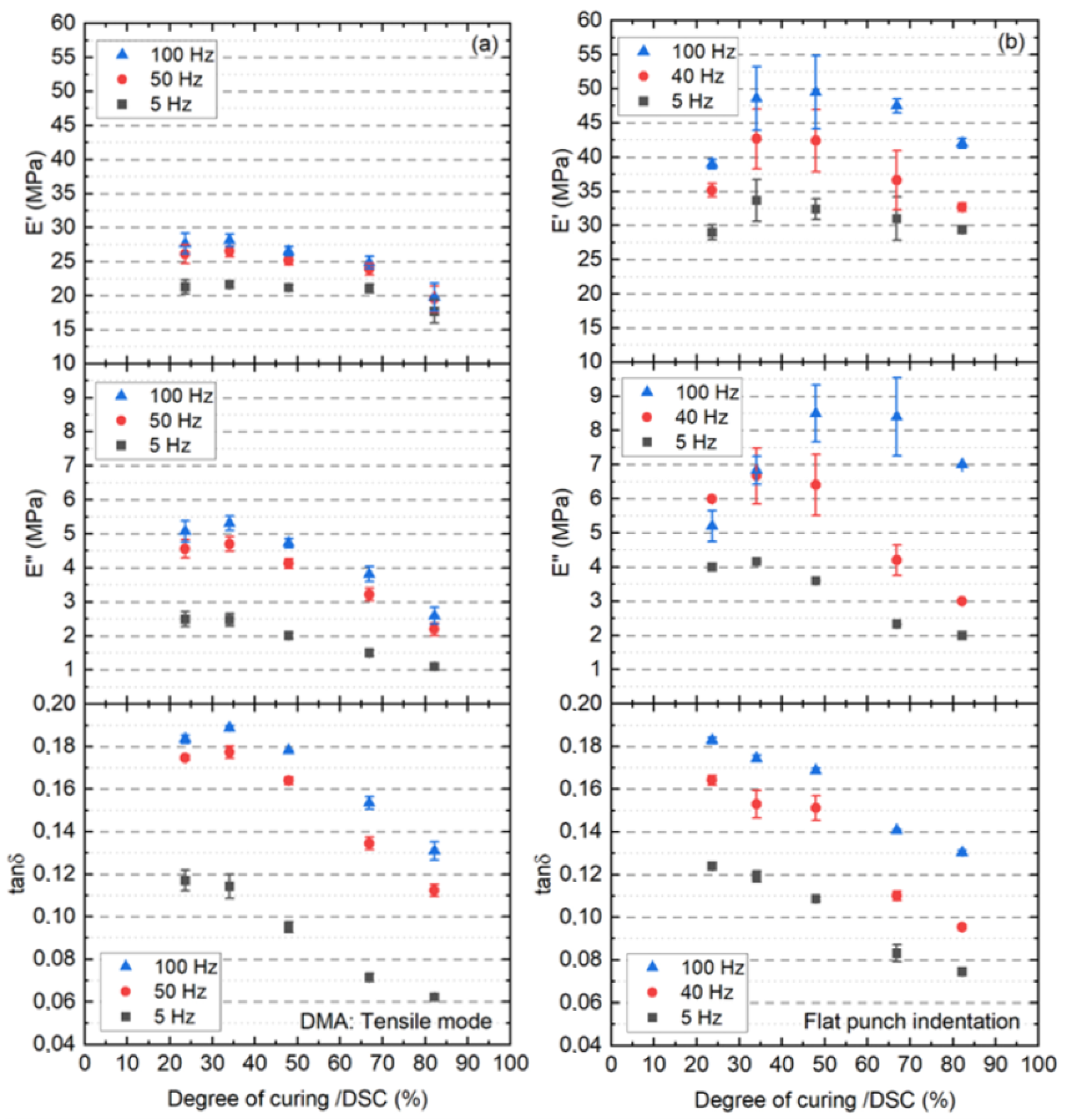
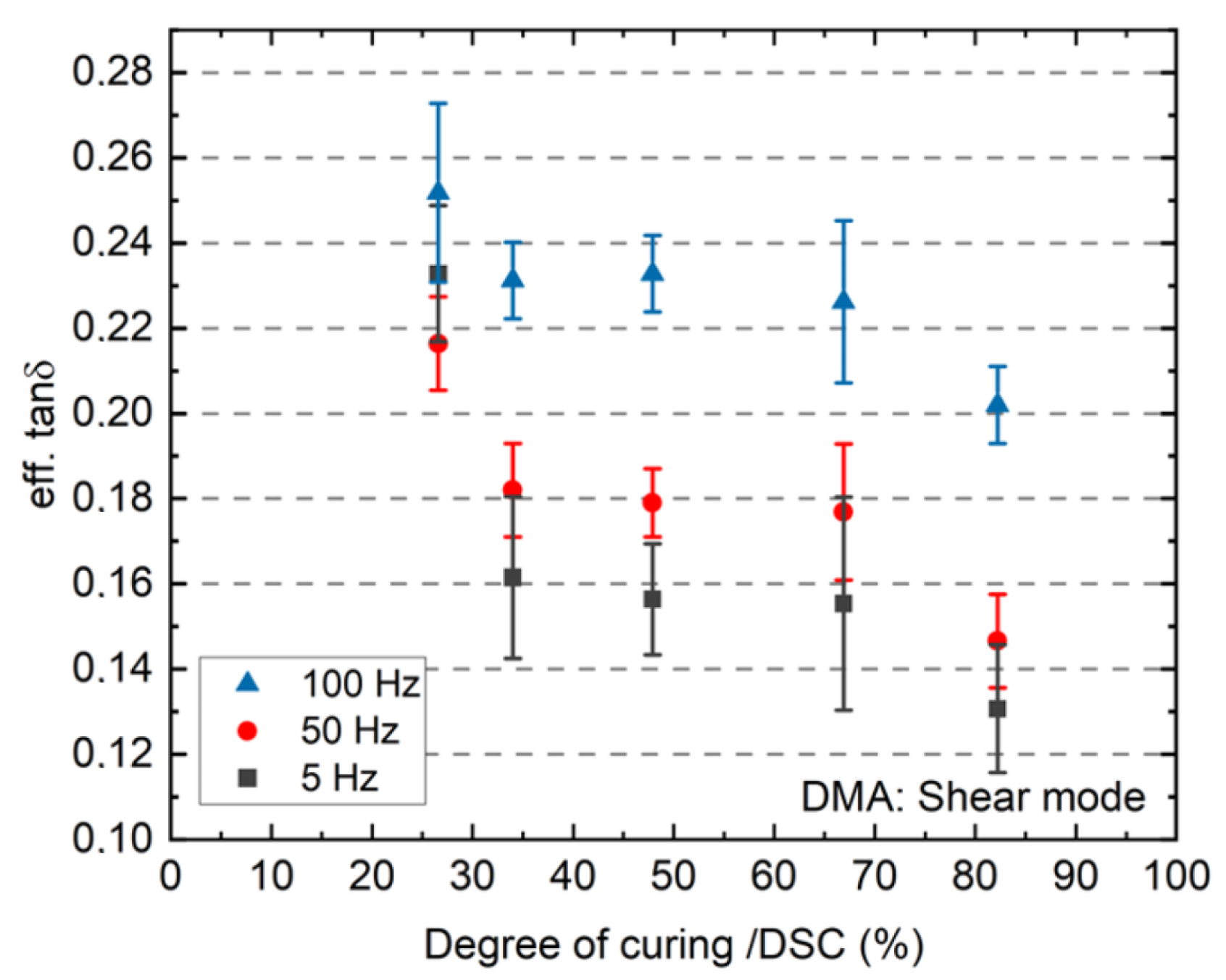
| Loading/unloading rate | 0.004 s |
|---|---|
| Maximum load | 40 mN |
| Holding time | 200 s |
| Constant strain rate | 0.05 s |
|---|---|
| Maximum load | 40 mN |
| Break before Sinus | 15 s |
| Sinus duration | 65 s |
| Sinus frequency | 5 Hz, 40 Hz, 100 Hz |
| Amplitude | 4 A |
| Parameter | Frequency (Hz) | |
|---|---|---|
| 50 | 0.67 | |
| storage modulus (E) | 10 | 0.39 |
| 1 | 0.10 | |
| 50 | 0.95 | |
| Loss modulus (E) | 10 | 0.96 |
| 1 | 0.92 | |
| 50 | 0.96 | |
| Damping factor () | 10 | 0.97 |
| 1 | 0.91 |
| Characterization | Material | Applicability to | Measured | Coefficient |
|---|---|---|---|---|
| Method-Mode | Response | PV Components | Variable | of Variation ** |
| NI-dynamic | EVA surface | laminates * | 0.4% | |
| DMA-shear | laminate bulk | laminates | 8.4% | |
| DMA-tensile | EVA bulk | EVA sheets | 1.9% |
Publisher’s Note: MDPI stays neutral with regard to jurisdictional claims in published maps and institutional affiliations. |
© 2021 by the authors. Licensee MDPI, Basel, Switzerland. This article is an open access article distributed under the terms and conditions of the Creative Commons Attribution (CC BY) license (https://creativecommons.org/licenses/by/4.0/).
Share and Cite
Mansour, D.E.; Herzog, C.; Christöfl, P.; Pitta Bauermann, L.; Oreski, G.; Schuler, A.; Philipp, D.; Gebhardt, P. Nanoindentation Reveals Crosslinking Behavior of Solar Encapsulants—The Methodological Advantages over Bulk Methods. Polymers 2021, 13, 3328. https://doi.org/10.3390/polym13193328
Mansour DE, Herzog C, Christöfl P, Pitta Bauermann L, Oreski G, Schuler A, Philipp D, Gebhardt P. Nanoindentation Reveals Crosslinking Behavior of Solar Encapsulants—The Methodological Advantages over Bulk Methods. Polymers. 2021; 13(19):3328. https://doi.org/10.3390/polym13193328
Chicago/Turabian StyleMansour, Djamel Eddine, Christoph Herzog, Petra Christöfl, Luciana Pitta Bauermann, Gernot Oreski, Andreas Schuler, Daniel Philipp, and Paul Gebhardt. 2021. "Nanoindentation Reveals Crosslinking Behavior of Solar Encapsulants—The Methodological Advantages over Bulk Methods" Polymers 13, no. 19: 3328. https://doi.org/10.3390/polym13193328








